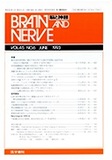Japanese
English
- 有料閲覧
- Abstract 文献概要
- 1ページ目 Look Inside
症例提示
症例 TM 70歳右利き男性(90-84551)。
主訴 右片麻痺,言語障害。
We report a 70-year-old man who had a sudden onset of right hemiparesis and mutism. The lower extremity was more involved than the upper one.
He had a long history of diabetes and chronic renal failure for which hemodialysis was necessary. On August 30, 1990, he had an sudden onset of right hemiparesis and mutism. Neurological examination revealed awake but mute in no acute distress. He could only respond to very simple commands such as opening his mouth or protruding his tongue. He did not appear to understand more difficult ques-tions. In addition, he could not answer verbally. He was totally mute. Cranial nerves appeared intact except for slight right central facial paresis and severe diabetic retinopathy. He had complete paraly-sis of his right leg and a moderate weakness in his right upper extremity. Deep reflexes were dimini-shed in both upper extremities and absent in the lower limbs. Frotal signs such as grasp and snout reflexes were present.
Cranial CT scans revealed an ill-defined low density area in the left parasagittal subcortical area and a part of the anterior cerebral artery territory. The supplementary motor area appeared at least in part to be involved. He was treated with glycerol and other supportive cares, however, his clinical course was complicated by pneumonia, heart fail-ure, septicemia, and he expired two months after hisstroke.
The patient was dicussed in a neurological CPCand the chief discussant arrived at a conclusion that he had an artery-to-artery embolism at the internal carotid bifurcation resulting in the cerebral infarc-tion mainly in the territory of the anterior cerebral artery.
Post-mortem examination revealed an infarct involving the territory of the left anterior cerebral artery, but the artery itself was patent. The infarct was thought to be of embolic nature. The supple-mentary motor cortex and its adjacent subcortical area was also involved.
This patient appeared important that his clinical feature, that is mutism and aphasia-like condition, appeared in all likelihood to be caused by a lesion in the dominant medial frontal lobe including the sup-plementary motor cortex and its efferent subcor-tical fibers.

Copyright © 1993, Igaku-Shoin Ltd. All rights reserved.


